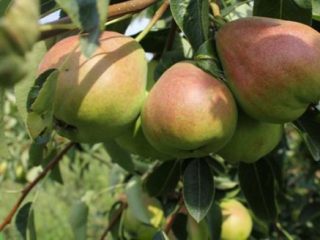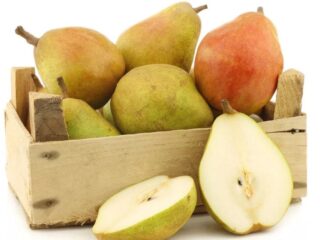Content
The pear, like the apple tree, is an equally common fruit tree. But in order for the yield to be in no way inferior, it is important to choose the right variety in accordance with the weather conditions of the region. For gardeners living in areas with a temperate climate, you can take a closer look at frost-resistant varieties. An excellent option would be the Permyachka pear, which is suitable for cultivation even in the Urals.

Permyachka pear combines increased frost resistance with high yield
History of selection
The Permyachka pear variety is the work of breeder Leonid Kotov, who sought to breed a fruit tree capable of growing not only in warm regions. The hybrid was bred at the Sverdlovsk horticulture breeding station in Yekaterinburg. It was obtained by crossing the varieties “Tema”, “Elena” and “Cosmic”.
Despite the fact that the Permyachka pear was bred specifically for the Perm, Sverdlovsk, Nizhny Novgorod and Kirov regions, it can be grown in the gardens of the Central and Northern regions. With proper care, the hybrid can easily grow even in Siberia. The Permyachka variety was included in the State Register in 2015.
Description of Permyachka pear with photo
The Permyachka pear has an unremarkable appearance, but is considered a fast-growing tree. Gardeners note that the plant has its own characteristics and needs proper care for active fruiting.
Tree
The height of the Permyachka pear can be up to 5 m. The tree itself is a fast-growing tree, capable of developing in any climatic conditions. The trunk is massive and branched. The crown is voluminous, pyramidal, which can also grow up to 5 m in diameter. There is a moderate amount of leaf mass, boat-shaped plates with a slightly pointed tip. The leaf color is dark green.
Fruit
The hybrid is distinguished by uniformly sized fruits, the weight of which can reach up to 200 g. Their shape is bell-shaped with slight ribbing. The skin is dense and thin, initially green in color, and yellow when ripe. If the fruits are exposed to abundant sunlight, a slight pinkish blush may appear on them; in the northern regions, the pear is often monochromatic.
In a longitudinal section, the seed core can be observed. The pulp is cream-colored and fine-grained in structure.

Tasting assessment of Permyachk pear – 5 points
Characteristics of the Permyachka pear
According to the characteristics, the Permyachka pear hybrid has its own characteristics.The fruit tree is intended for growing in gardens with a temperate climate; it is also successfully cultivated in the northern regions.
Taste qualities
The gastronomic indicator is high, since the taste of the fruits is sweet and very juicy. The Permyachka pear is universal in use. The fruits can be eaten directly from the tree, as well as after heat treatment.
Ripening time
Permyachka pear belongs to the fruit trees of the summer ripening period. The peak, when the fruits ripen en masse, occurs at the end of summer. By mid-September, the fruits begin to overripe, so gardeners try to collect them from late August to early September.
Productivity
The productivity of Permyachk pear is noted as high. From one tree you can collect up to 30 kg of high-quality fruits. The yield per hectare can reach approximately 200 centners.
Frost resistance of Permyachka pear
A healthy tree, subject to all care rules, can withstand frosts up to 45 ºC. If the winter is cold enough, proper autumn preparation will help you survive frosts without damage. Abundant watering and fertilizing are important. If possible, mulch the root zone.
Pollinators of the Permyachk pear
To get a bountiful harvest of the Permyachka pear variety, it requires the presence of pollinating trees nearby. It will be sufficient to grow one plant in an adjacent area. The Severyanka pear tree is considered suitable, and cross-pollination can also occur with other mid-season varieties.
Keeping quality
Permyachka pear fruits can last for about ten days after harvesting without loss of quality. Ideal storage conditions are considered to be between 0-3 ºC.
If the fruits were picked green, then for ripening they can be spread out in one layer in a warm room. Under such conditions, technical ripeness will be achieved within 3-4 days.

If fruits need to be transported over a long distance, they are collected in an unripe form.
Growing regions
The Permyachka pear was developed specifically for planting in the Perm region, Sverdlovsk and Kurgan regions. But due to its excellent winter hardiness and drought resistance, the variety is successfully cultivated in the Central region of Russia and in the Northern regions.
Disease resistance
The crop has a strong immunity to diseases and pest attacks, but if care is neglected, or the summer is sunny and cloudy, then there is a risk of illnesses. Therefore, in the spring it is necessary to carry out preventive measures.
Advantages and disadvantages
Like all fruit trees, the Permyachka pear has its advantages and disadvantages.

The Permyachka pear is considered popular among fruit crops among gardeners in the Middle Zone
Pros:
- precociousness;
- winter hardiness;
- resistance to various weather conditions;
- attractive appearance of the fruit;
- high taste qualities;
- resistance to diseases and pests;
- a bountiful harvest.
Minuses:
- rapid tree growth;
- pollination requires a partner.
Landing rules
To provide yourself with a high-quality pear harvest, the Permyachka variety requires compliance with planting rules.
Initially, it is important to choose a seedling. It should be no more than two years old, with a well-formed root system and healthy branches. The landing site is selected taking into account the following requirements:
- dry, illuminated area with fertile, loose soil;
- deep groundwater;
- lack of through winds.
Landing algorithm:
- Prepare the soil (weed, dig, fertilize).
- Dig a hole with a diameter of at least 60 cm and a depth of up to 50 cm.
- Drainage material is placed at the bottom of the hole, and fertile soil is poured on top in a layer of 10-15 cm.
- Place the seedling with the roots straightened.
- Fill in the remaining soil, tamp lightly and water generously.
- Mulching is done around the trunk.
Further care
After planting, further care is almost identical to what other fruit trees require. It consists of timely watering, fertilizing and pruning.
Permyachka pear loves abundant watering, but does not tolerate waterlogging. The soil should be moistened at least four times during the season. One tree will require at least 10 liters of water. If the summer is dry, then watering can be increased.
Fertilizing the soil also has a positive effect on the yield and development of the tree. It is advisable to feed the Permyachka pear four times during the growing season. Nitrogen-containing fertilizers should be applied in the spring, potassium-phosphorus compounds should be applied after flowering, and complex nutrient mixtures can be used in the fall.
You should not neglect removing weeds and loosening the soil. These actions are necessary to ensure that oxygen reaches the roots.
The tree definitely needs pruning.In spring, it is necessary for sanitary purposes to remove frostbitten and broken branches. In the fall, pruning is performed to form the crown.
Diseases and pests
Common diseases include: scab, fruit and gray rot, rust and powdery mildew.
To prevent them, Permyachk pears should be treated with copper sulfate, Bordeaux mixture, and lime mortar in the spring. When the first signs of disease appear, the tree should be cleaned of the affected areas and treated with Kuproxat and Fundazol.

If agrotechnical requirements are met, Permyachka pear rarely suffers from diseases
The pear can also be affected by insect pests: aphids, winter moths, gall mites and pear copperheads.
To prevent their occurrence, you can use folk remedies, for example, a soap solution with the addition of wood ash. As a preventive measure, the trunk is also whitewashed in the spring. In case of mass infestation by pests, the use of insecticides Zolon, Chlorofost, Fufanon and the like may be required.
Conclusion
Permyachka pear is considered an excellent option for gardeners living in regions with unfavorable climatic conditions. The tree pleases with a bountiful harvest. The fruits are distinguished by high taste, versatility in use and attractive appearance.
Reviews from gardeners about the Permyachka pear








